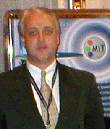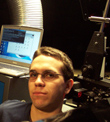|
|
 
|
|
Author
|
Topic: Academy Awards for Scientific and Technical achievement for 2003
|
Bevan Wright
Expert Film Handler

Posts: 176
From: Fountain Valley, CA, USA
Registered: Sep 2003
|
 posted 02-15-2004 06:33 AM
posted 02-15-2004 06:33 AM





Academy Awards for Scientific and Technical achievement for 2003 are:
---------------
Academy Award of Merit
(Oscar Statuette)
---------------
To Digidesign for the design, development and implementation of the Pro Tools® digital audio workstation.
The efficient algorithms, extensible architecture and intuitive interface have enabled Pro Tools® to become the worldwide standard for the creation and editing of motion picture soundtracks.
To Bill Tondreau of Kuper Controls for his significant advancements in the field of motion control technology for motion picture visual effects.
Measuring his valuable contributions to the invention and implementation of robotic camera systems in decades rather than years, his efforts have aided motion control in becoming a core technology that has supported the renaissance of visual effects.
---------------
Scientific and Engineering Awards
(Academy Plaques)
---------------
To Kinoton GmbH for the engineering and development of the
Kinoton FP 30/38 EC II Studio Projector.
This high-speed studio projector produces an image quality equal to projectors with Geneva movements. With its unparalleled shuttle speed, reversibility and acceleration this projector has set a new standard for post-production viewing as well as in traditional screening facilities.
To Kenneth L. Tingler, Charles C. Anderson, Diane E. Kestner, and Brian A. Schell of the Eastman Kodak Company, for the successful development of a process-surviving antistatic layer technology for motion picture film.
This technology successfully controls the static charge buildup on processed intermediate and sound negative films during high-speed printing operations.
To Christopher Alfred, Andrew J. Cannon, Michael C. Carlos, Mark Crabtree, Chuck Grindstaff, and John Melanson for their significant contributions to the evolution of digital audio editing for motion picture post production.
Through their respective pioneering efforts with AMS AudioFile, Waveframe and Fairlight, their work contributed significantly to the development and realization of digital audio workstations with full editing capabilities for motion picture soundtracks.
To Stephen Regelous for the design and development of Massive, the autonomous agent animation system used for the battle sequences in "The Lord of the Rings" trilogy.
Massive takes a new approach in simulating behaviors of large numbers of computer generated extras (a.k.a.) "agents." Each "agent" contains a primitive software "brain" used to develop behavioral rules simulating a wide range of behaviors. In "The Lord of the Rings" trilogy,over 200,000 agents were controlled in several scenes.
---------------
Technical Achievement Awards
(Academy Certificates)
---------------
To Kish Sadhvani for the concept and optical design, Paul Duclos for the practical realization and production engineering and Carl Pernicone for the mechanical design and engineering of the portable cine viewfinder system known as the Ultimate Director's Finder (UDF).
This versatile, modular and widely accepted cine viewfinder system is capable of properly displaying images in multiple formats ranging from 35mm anamorphic to super 16.
To Henrik Wann Jensen, Stephen R. Marschner and Pat Hanrahan for their pioneering research in simulating subsurface scattering of light in translucent materials as presented in their paper "A Practical Model for Subsurface Light Transport."
This mathematical model contributed substantially to the development and implementation of practical techniques for simulating subsurface scattering of light in translucent materials for computer-generated images in motion pictures.
To Christophe Hery, Ken McGaugh and Joe Letteri for their groundbreaking implementations of practical methods for rendering skin and other translucent materials using subsurface scattering techniques.
These groundbreaking techniques were used to create realistic-looking skin on digitally created characters.
| IP: Logged
|
|
|
|
|
|
|
|
Daryl C. W. O'Shea
Film God

Posts: 3977
From: Midland Ontario Canada (where Panavision & IMAX lenses come from)
Registered: Jun 2002
|
 posted 02-24-2004 08:25 PM
posted 02-24-2004 08:25 PM





http://www.msnbc.msn.com/id/4286834/
quote:
The Academy honors its technical geeks
Jennifer Garner hosted the pre-Oscar technical awards
Updated: 9:34 a.m. ET Feb. 20, 2004
LOS ANGELES - Jennifer Garner proved her range as actress when a Hollywood audience got to hear the star of ABC’s spy drama “Alias” expound on the merits of subsurface light scattering in translucent materials.
Garner hosted the Academy of Motion Picture Arts and Sciences Scientific and Technical Awards Saturday night, the pre-Oscar show where the movie industry honors people and companies that have advanced the process of filmmaking.
The technical Oscars are usually presented a few weeks before the main Academy Awards in an annual gala that positions itself as something of a revenge of the Hollywood nerds.
One honoree joked that Garner was the best part of the evening.
“I want to thank the Academy for inviting Jennifer Garner here tonight. Now I can brag to my friends I spent Valentine’s Day with Jennifer Garner,” said Henrik Wann Jensen, who along with two colleagues won a certificate for their research into subsurface light scattering, which has been used to make more realistic-looking skin on digital film characters.
Garner, who played along gamely earlier in the evening as a magician brought her on stage and attempted to shoot an arrow through a deck of cards clutched over her heart, confessed to being a “supernerd” herself, having originally majored in chemistry in college.
The audience cheered loudly whenever she pronounced a particularly daunting technical term properly.
Big winners
The main award winners of the night, receiving Oscars for their work, were Digidesign, for developing the Pro Tools digital audio workstation; Bill Tondreau of Kuper Controls, for his work with robotic camera systems; and Peter D. Parks, who won the Gordon E. Sawyer Award for lifetime achievement.
Parks, known for his intricate three-dimensional films of some of nature’s smallest creatures, said that his wife had often repeated a mantra to him that kept him focused.
“Mortgage first, health benefits second, education third, pension fourth, dog fifth, and then you can buy that lens,” Parks said she told him.
Among those honored with plaques were Kinoton GmbH for its high-speed studio projector; a team from Eastman Kodak Co. for developing an anti-static layer on film that survives processing; Stephen Regelous for developing Massive, the software used to create tens of thousands of warriors for the “Lord of the Rings” battle sequences; and a group of companies for their work in digital audio editing.
A certificate also went to a team headed by Kish Sadhvani for developing a viewfinder for directors that lets them see what their cameras will see without the actual camera equipment.
One of Sadhvani’s associates said it was strange for him to be up on stage after years of watching people carry on at awards show. “Tonight they called my name and I want to make a fuss,” Carl Pernicone said.
| IP: Logged
|
|
|
|
All times are Central (GMT -6:00)
|
|
Powered by Infopop Corporation
UBB.classicTM
6.3.1.2
The Film-Tech Forums are designed for various members related to the cinema industry to express their opinions, viewpoints and testimonials on various products, services and events based upon speculation, personal knowledge and factual information through use, therefore all views represented here allow no liability upon the publishers of this web site and the owners of said views assume no liability for any ill will resulting from these postings. The posts made here are for educational as well as entertainment purposes and as such anyone viewing this portion of the website must accept these views as statements of the author of that opinion
and agrees to release the authors from any and all liability.
|

 Home
Home
 Products
Products
 Store
Store
 Forum
Forum
 Warehouse
Warehouse
 Contact Us
Contact Us




 Printer-friendly view of this topic
Printer-friendly view of this topic













